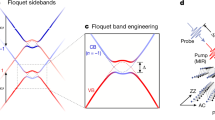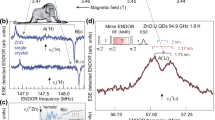Abstract
In a typical EPR experiment, the transitions require that the static magnetic field \(B_0\) is oriented perpendicular to the microwave field \(B_1\) (perpendicular mode). This is determined by the transition rules either in the classical or in the quantum mechanical description. However, there are cases where EPR transitions are observed when \(B_0\) is oriented parallel to \(B_1\) (parallel mode). Quite numerous studies can be found in the literature where EPR transitions in both modes (dual-mode EPR) are feasible. In the majority of cases, dual-mode EPR studies are typically applied in \(S>1/2\) systems where non-zero transition probabilities for the parallel mode are the result of the state mixing provided by the zero-field splitting interaction. On the other hand, the observation of parallel-mode EPR signals in \(S=1/2\) systems becomes feasible when strong hyperfine interaction between the electronic and nuclear spin is present, as has been theoretically predicted for the hydrogen atom having a hyperfine coupling constant of \(A_0=1420\) MHz (Weil in Concepts Magn Reson Part A 28:331, 2006). Herein, we report the first dual-mode X-band EPR experiments of hydrogen atom (both isotopes \(^1\)H and \(^2\)H) encapsulated in polyhedral oligomeric silsesquioxane cages. We extend the theory to the case of deuterium and we extract analytical formulas for transition probabilities. For the forbidden transitions, this study revealed a first-order dependence of resonance fields on the nuclear g-factor, \(g_{\mathrm{n}}\), and the existence of a clock transition with \(f=307\) MHz.







Similar content being viewed by others
References
M.P. Hendrich, P.G. Debrunner, J. Magn. Reson. 78, 133 (1988)
M. Hendrich, P. Debrunner, Biophys. J. 56, 489 (1989)
B.S. Pierce, T.E. Elgren, M.P. Hendrich, J. Am. Chem. Soc. 125, 8748 (2003)
T.D. Tzima, G. Sioros, C. Duboc, D. Kovala-Demertzi, V.S. Melissas, Y. Sanakis, Polyhedron 28, 3257 (2009)
A. Bencini, D. Gatteschi, EPR of Exchange Coupled Systems (Springer, Heidelberg, 1990)
A. Galani, E.K. Efthimiadou, G. Mitrikas, Y. Sanakis, V. Psycharis, C. Raptopoulou, G. Kordas, A. Karaliota, Inorg. Chim. Acta 423, 207 (2014)
L. Mathivathanan, A.K. Boudalis, P. Turek, M. Pissas, Y. Sanakis, R.G. Raptis, Phys. Chem. Chem. Phys. 20, 17234 (2018)
J.A. Weil, J.R. Bolton, Electron Paramagnetic Resonance: Elementary Theory and Practical Applications, 2nd edn. (Wiley, New Jersey, 2007)
J.A. Weil, Concepts Magn. Reson. Part A 28, 331 (2006)
R.T. Harding, S. Zhou, J. Zhou, T. Lindvall, W.K. Myers, A. Ardavan, G.A.D. Briggs, K. Porfyrakis, E.A. Laird, Phys. Rev. Lett. 119, 140801 (2017)
J. Isoya, J. Weil, P. Davis, J. Phys. Chem. Solids 44, 335 (1983)
K. Nakashima, J. Yamauchi, J. Am. Chem. Soc. 127, 1606 (2005)
D.Y. Koh, H. Kang, J. Park, W. Shin, H. Lee, J. Am. Chem. Soc. 134, 5560 (2012)
S.N. Foner, E.L. Cochran, V.A. Bowers, C.K. Jen, J. Chem. Phys. 32, 963 (1960)
S. Sheludiakov, J. Ahokas, J. Järvinen, L. Lehtonen, S. Vasiliev, Y.A. Dmitriev, D.M. Lee, V.V. Khmelenko, Phys. Rev. B 97, 104108 (2018)
M. Paech, R. Stoesser, J. Phys. Chem. A 101(44), 8360 (1997)
Y. Matsuda, Appl. Magn. Reson. 23(3–4), 469 (2003)
R.S. Schoenfeld, W. Harneit, M. Paech, Phys. Status Solidi B 243(13), 3008 (2006)
B. Gross, H. Dilger, R. Scheuermann, M. Paech, E. Roduner, J. Phys. Chem. A 105(44), 10012 (2001)
N. Weiden, M. Paech, K. Dinse, Appl. Magn. Reson. 21, 507 (2001)
G. Mitrikas, Phys. Chem. Chem. Phys. 14, 3782 (2012)
G. Mitrikas, E.K. Efthimiadou, G. Kordas, Phys. Chem. Chem. Phys. 16, 2378 (2014)
G. Mitrikas, S. Menenakou, Phys. Chem. Chem. Phys. 22, 15751 (2020)
R.S. Dickson, J.A. Weil, Am. J. Phys. 59, 125 (1991)
S. Stoll, A. Ozarowski, R.D. Britt, A. Angerhofer, J. Magn. Reson. 207, 158 (2010)
M.H. Mohammady, G.W. Morley, T.S. Monteiro, Phys. Rev. Lett. 105, 067602 (2010)
S.J. Balian, M.B.A. Kunze, M.H. Mohammady, G.W. Morley, W.M. Witzel, C.W.M. Kay, T.S. Monteiro, Phys. Rev. B 86, 104428 (2012)
G. Wolfowicz, A.M. Tyryshkin, R.E. George, H. Riemann, N.V. Abrosimov, P. Becker, H.J. Pohl, M.L.W. Thewalt, S.A. Lyon, J.J.L. Morton, Nat. Nanotechnol. 8, 561 (2013)
S.J. Balian, G. Wolfowicz, J.J.L. Morton, T.S. Monteiro, Phys. Rev. B 89, 045403 (2014)
M. Shiddiq, D. Komijani, Y. Duan, A. Gaita-Ariño, E. Coronado, S. Hill, Nature 531, 348 (2016)
Y. Hagiwara, A. Shimojima, K. Kuroda, Chem. Mater. 20(3), 1147 (2008)
S. Stoll, A. Schweiger, J. Magn. Reson. 178(1), 42 (2006)
J.A. Weil, D.F. Howarth, Appl. Magn. Reson. 38(1), 85 (2010)
F.J. Adrian, J. Chem. Phys. 32(4), 972 (1960)
C.J. White, A.H. Hajimiri, in Proceedings of the 2005 IEEE International Frequency Control Symposium and Exposition (2005), pp. 940–946. https://doi.org/10.1109/FREQ.2005.1574061
A.M. Tyryshkin, J.J.L. Morton, S.C. Benjamin, A. Ardavan, G.A.D. Briggs, J.W. Ager, S.A. Lyon, J. Phys. Condens. Matter 18, S783 (2006)
R.E. George, W. Witzel, H. Riemann, N.V. Abrosimov, N. Nötzel, M.L.W. Thewalt, J.J.L. Morton, Phys. Rev. Lett. 105, 067601 (2010)
M.H. Mohammady, G.W. Morley, A. Nazir, T.S. Monteiro, Phys. Rev. B 85, 094404 (2012)
G.W. Morley, P. Lueders, M.H. Mohammady, S.J. Balian, G. Aeppli, C.W.M. Kay, W.M. Witzel, G. Jeschke, T.S. Monteiro, Nat. Mater. 12, 103 (2013)
Acknowledgements
We acknowledge support of this work by (a) the project MIS 5002567, implemented under the “Action for the Strategic Development on the Research and Technological Sector” and (b) the project MIS 5002772, “National Infrastructure in Nanotechnology, Advanced Materials and Micro-/Nanoelectronics” which is implemented under the Action “Reinforcement of the Research and Innovation Infrastructure”. Both projects are funded by the Operational Programme “Competitiveness, Entrepreneurship and Innovation” (NSRF 2014-2020) and co-financed by Greece and the European Union (European Regional Development Fund). The authors are also indebted Dr. Raanan Carmieli, Weizmann Institute of Science, for providing the deuterated chlorosilane.
Author information
Authors and Affiliations
Corresponding author
Additional information
This work is dedicated to Prof. Dante Gatteschi on the occasion of his 75th birthday in recognition of his outstanding contribution in Electron Paramagnetic Resonance Spectroscopy.
Publisher's Note
Springer Nature remains neutral with regard to jurisdictional claims in published maps and institutional affiliations.
Rights and permissions
About this article
Cite this article
Mitrikas, G., Sanakis, Y. & Ioannidis, N. Parallel-Mode EPR of Atomic Hydrogen Encapsulated in POSS Cages. Appl Magn Reson 51, 1451–1466 (2020). https://doi.org/10.1007/s00723-020-01263-5
Received:
Revised:
Published:
Issue Date:
DOI: https://doi.org/10.1007/s00723-020-01263-5




